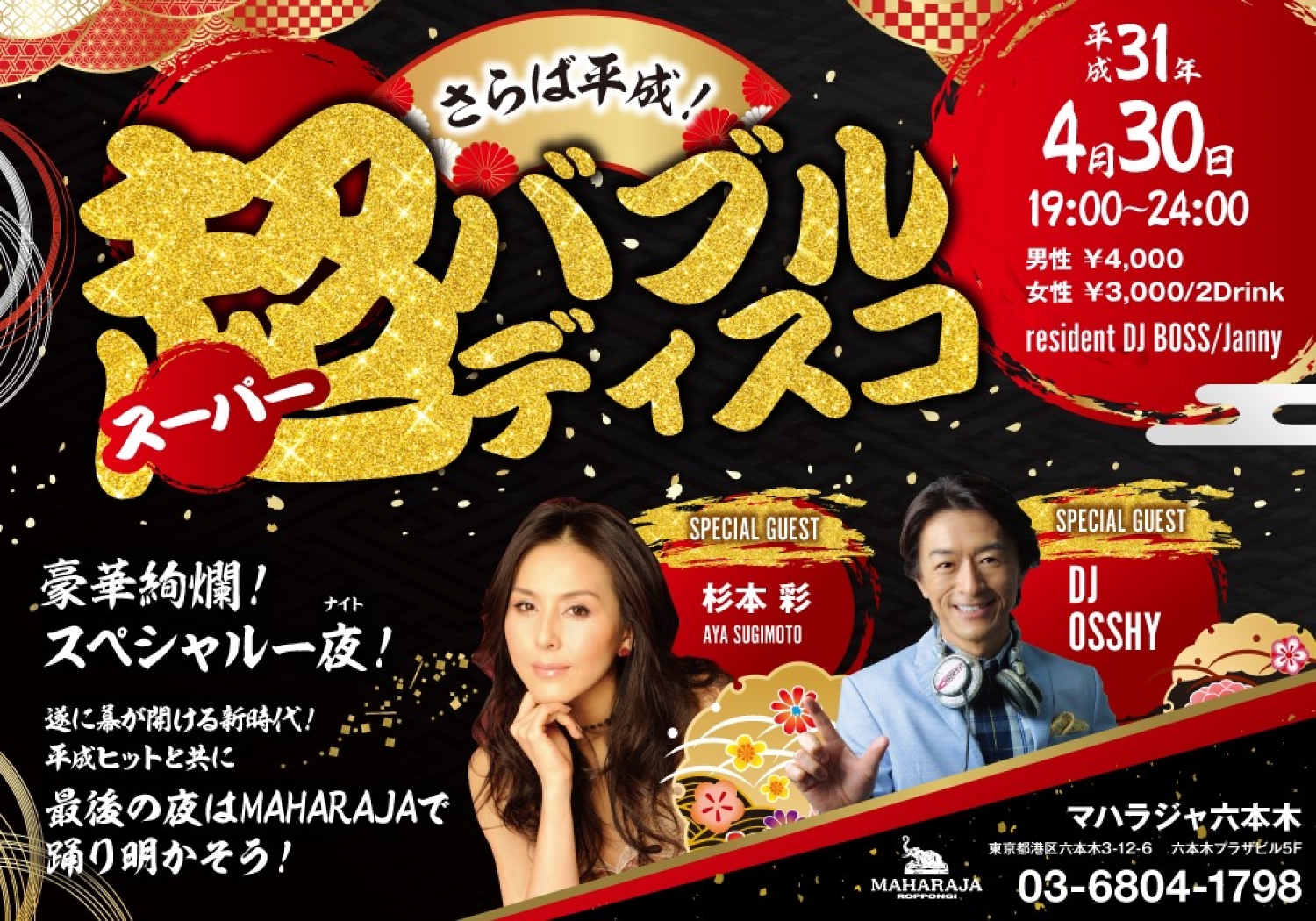実績一覧
主な実績
- 2019.05.07
ロイター通信 世界各国に配信
平成31年4月30日 さらば平成超バブルディスコの様子が取り上げられました!

記事内容
https://www.reuters.com/article/us-japan-emperor-era-disco/discos-back-japan-grooves-to-bubble-beat-for-heisei-era-sayonara-idUSKCN1S72Y9?fbclid=IwAR1SuyFsGWa-6Wrbt9N-k9nZuYbqzu6pZlu4B9w6snLXr8RFg-uR7GT6SD8
TOKYO (Reuters) - Japanese disco fans hit the dance floor and partied like it was 1989, reliving the glitz of the “bubble economy” heyday that defined the early years of the outgoing Heisei imperial era.
Tuesday night was the last chance for nostalgic Japanese to bid sayonara to the three-decade Heisei era, which ended at midnight with the abdication of retiring Emperor Akihito.
New Emperor Naruhito’s reign begins Wednesday, ushering in the Reiwa imperial era, meaning “beautiful harmony.”
In an echo of the heady “bubble economy” days of early Heisei, women in slinky dresses at the Maharaja Roppongi disco grooved to the beat while mirror balls glittered and veteran disco personality DJ Osshy spun the turntables, with the party culminating in a midnight countdown.
“I used to go to Maharaja every Friday night in the early Heisei days. I feel like I’ve gone back in time,” said Yu Inada, a homemaker.
Inada brought for the occasion a white feather fan, a must-have accessory in the bubble days that she had held on to since then.
“Back then everyday was fun. It was a gorgeous era. Nowadays things are a little plain,” she said before hopping on the elevated stage to strut her stuff.
Shirin Higashi, a 54-year-old esthetician, came for the countdown.
“I thought it would be more fun with everyone here than at home alone. I’m happy I could take part in the celebration,” she said.
Heisei began in early 1989 at the height of a stock market and real estate bubble, where it seemed money came easy and the good times would never end.
That exuberance fueled Japan’s nightlife, with discos like Maharaja and Juliana’s becoming a symbol of the fun and excess of the late ‘80s and early ‘90s go-go years.
But with the collapse of the bubble in the early 1990s and subsequent “lost decade” of economic stagnation, extravagance was out and these clubs eventually closed.
Times change, however, and the strobe lights are coming back on.
Maharaja relaunched under new management in 2010 and has now opened six locations, targeting 40 to 60-year-olds, while Juliana’s reopened in Osaka in October.
DJ Osshy hosts regular Sunday Disco parties during adult-friendly afternoon hours, and last year established a national “Disco Day” on July 22 - the date when “Saturday Night Fever” premiered in Japan in 1978.
“Disco music has the power to make people move their body and feel energetic and happy, regardless of what era we’re in,” DJ Osshy told Reuters after his set.
“From kids to senior citizens, it’s something we all have in common,” he said. “It transcends generations.”
Reporting and writing by Chris Gallagher; editing by Malcolm Foster and Michael Perry
和訳ディスコ復活 平成時代とのさよならを バブル音楽ビートで大いに楽しむ! 東京ロイター
日本のディスコファンは ダンスフロアに行き、1989年のようにパーティーをした。平成時代を定義づける派手なバブル経済の全盛期を思いださせるような!
火曜日の夜はノスタルジックな日本人が 30年の平成という時代にさよならを告げる 最後の夜となった。それは明仁様の退位する深夜にまでおよんだ。
新天皇 徳仁様の治世は水曜日より始まり美しい調和を意味する 「令和」 を先導する。
火曜日の夜はノスタルジックな日本人が 30年の平成という時代にさよならを告げる 最後の夜となった。それは明仁様の退位する深夜にまでおよんだ。
新天皇 徳仁様の治世は水曜日より始まり美しい調和を意味する 「令和」 を先導する。
平成初期のバブル時代に同調して マハラジャ六本木ではセクシーなドレスを着た女性たちがミラーボールのキラキラした中でディスコのグルーヴにのり、ベテランディスコパーソナルDJ OSSHYがターンテーブルを回し深夜のカウントダウンを頂点にもっていこうとしていた。
「平成初期には毎週金曜日の夜はマハラジャに行ってました。あの時代に戻ったようです。」 イナダ ユウさん(専業主婦) イナダさんはバブル期からずっと持っていた必須アイテムである白い羽根の扇子を持ってきていた。 「その当時は毎日楽しかった。素晴らしい時代だった。最近は少しつまらない。」とステージに上がる前に言った。
ヒガシさん(54歳 エステティシャン) 「一人で家にいるより ここにいる皆と過ごしたほうが楽しいと思った。このお祝いに参加できて嬉しいわ。」と彼女は言った。
平成は1989年の初めに始まった。株式市場は高く、不動産は高騰、簡単にお金が手に入り、この良い時代がいつまでも終わらないと思われた。
この活気は日本のナイトライフを加速させた マハラジャやジュリアナのようなディスコは80年~90年代のイケイケな時代の象徴となった。しかし1990年初期のバブル崩壊により浪費は止まり これらのディスコは徐々に閉鎖された。
時代は変わるが 光りは戻りつつある。マハラジャは2010年に新体制となり 6ヶ所にオープンした。ターゲットは40~60代、ジュリアナも10月に大阪に再オープンした。
DJ OSSHYは日曜日に定期的にディスコパーティーを開き 昨年7月22日に 国民ディスコデー を設立した。1978年日本で「サタデーナイトフィーバー」が封切られた日だ。
「ディスコ音楽は人に身体を動かさせ、活力を与え幸せにする力がある。それはどんな時代に生きていても変わらない。」 DJ OSSHY が教えてくれた。「子供からお年寄りまでみんな共通で持っているものだ。世代を越えるものなんだ!」と彼は言った。

